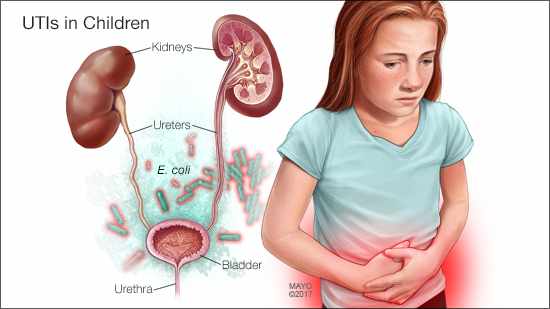-
Featured News
Mayo Clinic Q and A: Urinary tract infections in children
 DEAR MAYO CLINIC: What could be the cause of recurrent urinary tract infections in kids? Is it possible to prevent them, or are some kids just more susceptible?
DEAR MAYO CLINIC: What could be the cause of recurrent urinary tract infections in kids? Is it possible to prevent them, or are some kids just more susceptible?
ANSWER: Urinary tract infections, or UTIs, usually happen when bacteria get into the urinary tract through the urethra and begin to multiply in the bladder. In children, the most common causes of UTIs are constipation, incomplete bladder emptying and holding urine. You and your child can take several steps that may decrease the likelihood of recurrent UTIs.
A UTI is an infection in any part of the urinary system — the kidneys, ureters, bladder and urethra (the tube that carries urine from your bladder out of your body). Most infections involve the lower urinary tract — the bladder and the urethra. UTIs in children typically include symptoms such as a strong, persistent urge to urinate; a burning or painful sensation when urinating; or passing frequent, small amounts of urine.
In some cases, a UTI may lead to pelvic pain. Some children also may develop a fever. Although uncommon, the presence of a fever, back pain or vomiting may signal a more serious infection that could be affecting the kidneys. If your child has these symptoms, see his or her primary care provider for an evaluation right away. A referral should be made to see a pediatric urologist if your child has had a UTI accompanied by a fever.
Constipation is a frequent cause of UTIs in children. If stool fills up the rectum and colon, it can place pressure on, or even obstruct, the bladder, so the bladder cannot empty completely. The urine left in the bladder can be the perfect place for the growth of bacteria that may cause infection.
If your child has constipation, it’s important to treat it promptly. In most cases, children should have at least one soft bowel movement a day. If that’s not happening, talk to your child’s health care provider. Treatment for constipation ranges from self-care steps — such as eating more high-fiber foods, being more physically active and drinking more fluids (especially water) — to medication, such as stool softeners, fiber supplements and laxatives.
Children also may develop a UTI if they hold urine in for long periods of time, or if they don’t relax their pelvic floor muscles completely when they urinate. Encourage your child to use the bathroom regularly — about every two hours during the daytime. Make sure your child isn’t rushing when using the bathroom, but instead takes time to empty the bladder completely. Teach girls to wipe carefully from front to back after going to the bathroom.
The benefits of cranberry in helping to prevent and treat UTIs are often highlighted. But no solid evidence shows that it’s effective for children with recurrent UTIs. If you want to learn more, talk to your child’s health care provider.
Probiotics also have been publicized as being able to help to prevent UTIs. Found in food such as yogurt, these microorganisms are a type of “good” bacteria that may help with digestion and protect the body from harmful bacteria. Their overall benefit in children with UTIs is debatable. If you want to learn more, talk to your child’s health care provider.
It is possible that an anatomic abnormality or problems with a child’s immune system can lead to recurrent UTIs without fevers, but both of these situations are rare.
If your child continues to have UTIs despite taking measures at home and in conjunction with your child’s health care provider to help prevent them, make a follow-up appointment to see your child’s health care provider. By reviewing the child’s symptoms and medical history, as well as doing a physical exam, your provider may be able to shed light on the underlying cause of recurrent UTIs, and determine if a referral to a subspecialist is necessary. — Dr. Candace Granberg, Urology, Mayo Clinic, Rochester, Minnesota







